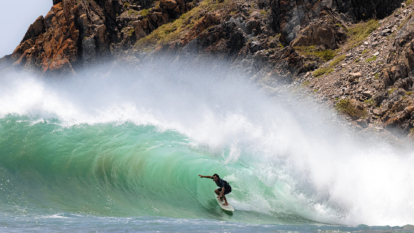The Wave below the Sleeping Rabbit
All photos by Ryan “Chachi” Craig
Uriel Camacho invented the sport of bodysurfing. At least, he thought he did.
This was before Salina Cruz, a town on the edge of the southern state of Oaxaca, Mexico, became an international surf destination. Before its sand-bottom pointbreaks would plaster magazines. Before the all-inclusive camps, 4×4 trucks and direct flights weighing heavy with board bags.
Camacho had no reference for wave riding of any kind 30 years ago. One day, he just kicked his way out to an empty wave and taught himself to swim. “Hola, hola, ¿cómo estás?” he shouted at the sea. “No me vayas a ahoga.” (“Hello, hello, how are you? Please don’t drown me.”)
“One day, I caught a wave,” he tells me, holding his arm straight in front of him. “I thought I was the first one to do it.”
Camacho, 44, now runs Luna Coral Soul Surf, a camp named after his two daughters. He is stocky, with a long, dark ponytail, sunbaked skin, a hook nose and deep smile lines—the result of spending nearly every day of the last 13 years as a surf guide under the brutal Oaxacan sun.
He recounts his bodysurfing story over mezcal at his dining room table. It’s dark, and I have just arrived from the airport. As soon as I get my luggage to my room, he demands that we take a shot, a celebration of the coming swell set to arrive in two days, the biggest of the summer. We clink, “¡salud!”
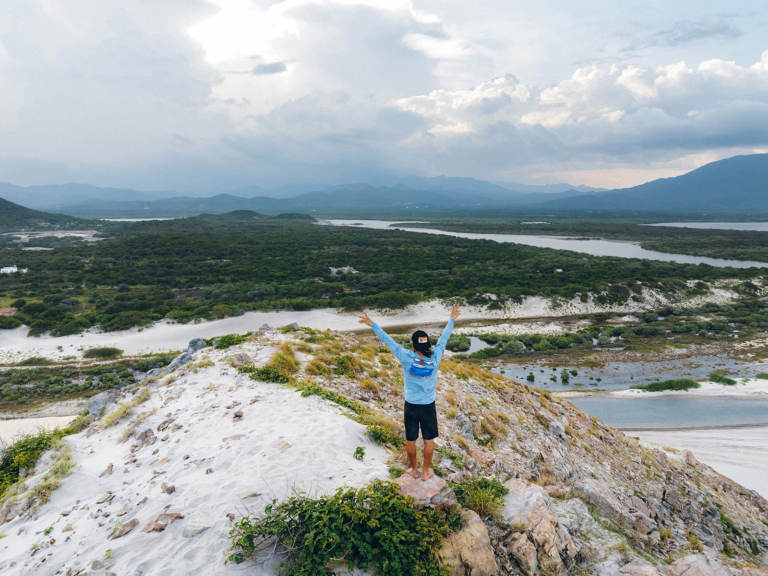
Camacho praises the mangroves. The proposed port would cut through this grove and alter the sand-bottomed goodness of Salina Cruz for worse.
I met Camacho a month prior in Northern California. We both attended a summit organized by the Save The Waves Coalition—an environmental nonprofit that protects surf ecosystems. “Visit anytime,” he offered, surely not expecting that I would actually take him up on it.
Camacho’s surf camp is on the backside of Punta Conejo, a right pointbreak on the edge of a sand-covered mountain that resembles a sleeping rabbit. Directly inland from Punta Conejo are mangroves, a forest of thirsty trees and visible root systems that are home to a small industry of shrimp fishermen who cast their nets along the still, windless water.
Beyond the mangroves is the city of Salina Cruz. It’s a port town of more than 80,000 with a newly finished harbor for international shipping vessels, most transporting petroleum. Mexico’s President, Andrés Manuel López Obrador, is planning to expand the project. It will gut Punta Conejo, relocate Camacho and his family, along with four surrounding communities and a number of other surf camps in the Playa Brasil area, and dredge thousands of hectares of mangroves to stage excess petroleum ships.
Camacho has a mission to stop it.
He is working with Save The Waves, Wildcoast, Union de Surfistas y Salvavidas de Salina Cruz and more conservation groups to designate Punta Conejo and the nearby Punta Chivo and Escondida as protected areas.
Flattening Salina Cruz’s most consistent wave with a sea of cement would also send the shrimp industry belly-up and dredge the delicate ecosystems surrounding the break. Just north of Playa Brasil’s long stretch of beach, the new development would destroy the breeding and hatching ground of the vulnerable leatherback and olive ridley sea turtles native to the area.
Unfortunately, Mexico has a history of ruining world-class surf spots. In the 1970s, a beachbreak version of O‘ahu’s Pipeline called Petacalco, which would have banked hundreds of millions in surf tourism dollars over the years, was destroyed. As Gerald Saunders wrote in The Surfer’s Journal: “Thanks to the underwater canyon to the south and the damming and jetty construction on the Rio Balsas a few miles to the north, there was no way the sandbars could be replenished as rapidly as the surging swell washed them away. What might have taken several more years was done literally overnight. Petacalco was gone.”
On June 2, 2024, President Andrés Manuel López Obrador is up for reelection. This means he could try to hastily move the Punta Conejo project forward before designation can be set. Hopefully, he recognizes the injustice of the project and the activists persuade him to see the wave as a valuable tourist attraction better left alone.
“Están locos,” Camacho says as he shakes his head after bringing me up to speed on the issue.
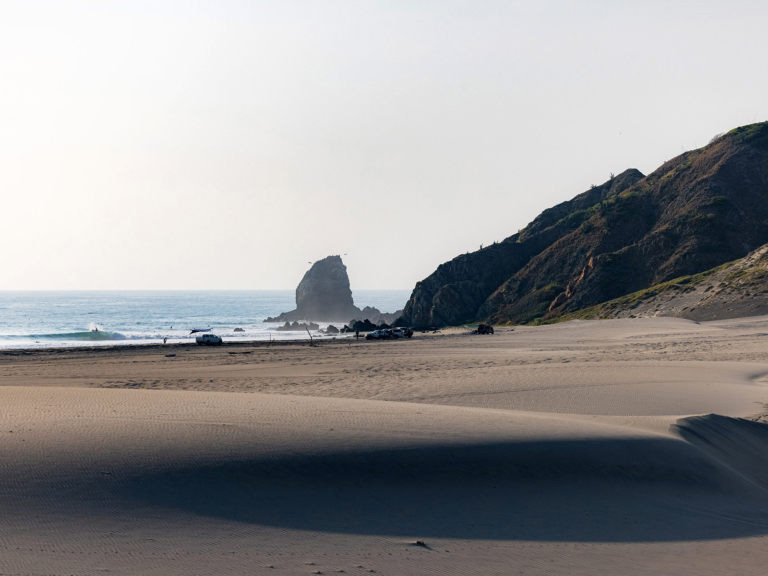
Your humble author takes one off the top at Punta Chivo.
The next morning, we pack our boards into Camacho’s black, salt-rusted SUV and drive to Punta Conejo, 10 minutes away. We bump along a dirt road, passing goats, burning trash and cacti with barbs big enough to impale a man. He shifts into four-wheel drive, and we skid along the sand to the point.
Five other trucks are already there, and surfers stand around in tank tops and boardshorts while small waves yawn down the point. It’s a shame, as part of the reason I’m down here is to report on the proposed port at the “world-class” Punta Conejo.
“No sand,” Camacho says, turning to me. It’s September, the end of the popular surf season for Oaxaca, and south wind has eroded the sandbar at Conejo. We watch a while longer and decide to check the next spot a few miles north: Punta Chivo, named because the rock at the end of the point looks like a goat.
Chivo is better. At least the pros make it look better. Their filmers hide under canopies next to the trucks capturing every wave in high definition. And the lineup of surf guides know that at 10 a.m. guests will get thirsty, so they stock coolers with water, electrolytes and beer. Today, the surf camps have their program dialed. As I wax my board for the first session, the efficiency of the whole experience is not lost on me.
Though this pampered scene isn’t the rugged bushwhacking of Gerry Lopez in the ’70s, these crowds may be the not-so-secret weapon to stopping the port expansion. The number of flights into Salina Cruz’s main airport, Bahías de Huatulco, has nearly quadrupled since 1997, from 123,000 per year to 452,000 per year. If the international surf community makes enough noise, and the Mexican government begins to see these waves as the multimillion-dollar cash registers that they are, they could halt the development.
After we surf Chivo for a few hours, Camacho and I sit in beach chairs and I crack a cold beer—it’s 10 a.m. and seems like the right thing to do. As I sip, Camacho tells me about Salina Cruz before the crowds, tourism and media.
When he was young, the points were empty. There were rumors of the odd expat surfer, but Camacho never saw them. He didn’t know the sport of surfing existed, or that those waves he learned to bodysurf would be worth millions in gringo tourism a few decades later.
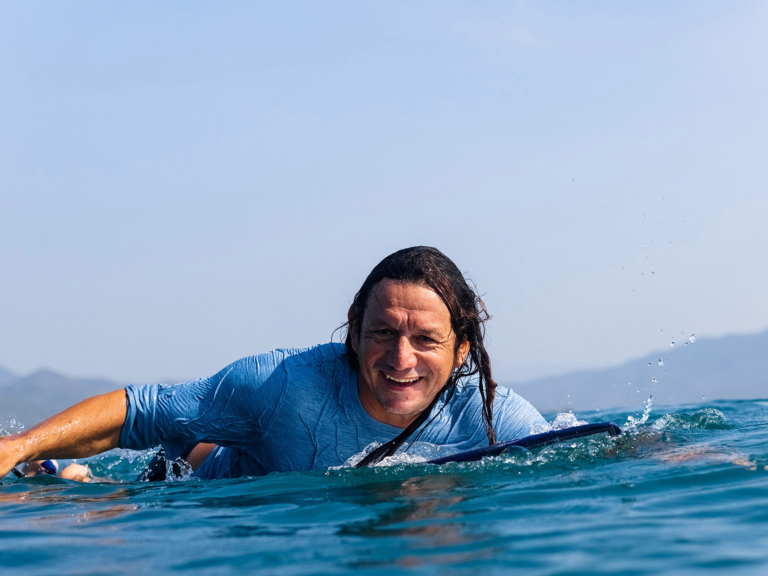
As a surfer, you stay stoked when some of the world’s best pointbreaks churn in your backyard. Camacho is no exception.
When he was 18, he took a bus four hours north to Puerto Escondido to work a factory job. There, he would learn that he did not, in fact, invent the sport of bodysurfing.
“They were doing my sport!” Camacho shouted after watching a bodysurfer glide down the face of a wave at the famed beachbreak.
While in Puerto Escondido, he also saw surfers. What a strange sport it was—swimmers, wielding foam and fiberglass, standing erect, swallowed by dark holes in the ocean, reappearing untouched, hands over their heads in rapturous wonder.
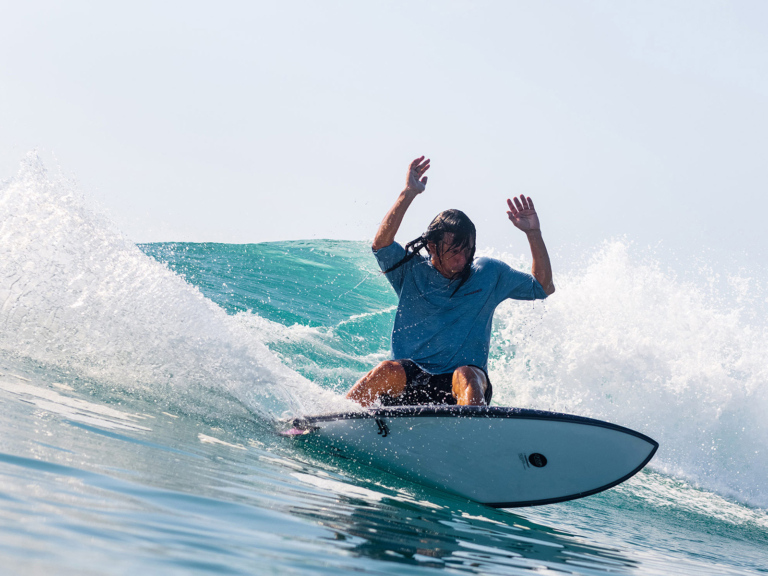
When your surf guide’s styling out like this, you know you’re in good company.
Not long after, Camacho was at a flea market. The way he tells the story, he wasn’t looking for anything in particular. He was just strolling around when it appeared. The crowd parted and, in the distance, he saw it. He shoved his way through the masses, approached, haggled and purchased. He brought the old 7’0″ single fin back to Salina Cruz, where he and his friends would stand on the beach at Punta Conejo and trade off riding it. There, he taught himself how to surf.
In the early 2000s, more gringo surfers showed up. In 2006, the Rip Curl Search contest blew up the area to the north, Barra de la Cruz, and word of endless pointbreaks in southern Mexico got out. For a few years, surf media never named Salina Cruz in photos or video, captions just read “Mexico.” But slowly discretion slipped away. Locals advertised surf camps and made rules: If you want to surf here, you have to pay. Gringos who didn’t pay would be threatened. Photographers were charged extra.
“What do you say to people who think the ocean is for everyone?” I ask Camacho.
“We gotta do it, man,” he says. “Look at Puerto Escondido. Locals don’t own land near the beach there anymore.”
Oaxaca is one of the poorest states in Mexico, and gringo surfers with enough disposable income to travel there likely earn more in a month than most locals do in a year. And surf camps don’t keep all the money; instead, surf tourism helps prop up the community. The surf camps pay a kind of “membership fee” to the various subcommunities closest to each wave. The subcommunities then decide where the money will go—a new road, school or medical center.
After the day at Chivo, we drive back for dinner. Camacho’s wife, Linda, makes us fresh fish tacos. She wears a Pink Floyd T-shirt and is just about the nicest person I’ve ever met. On the walls of the dining room are photos of each wave at its best, along with a signed surfboard from World Surf League champion Filipe Toledo, a former guest at Luna Coral.
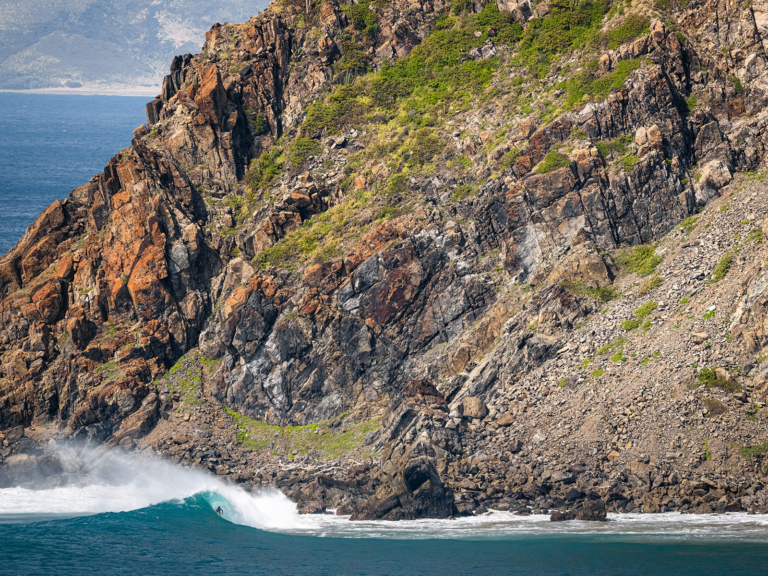
Kyle Thiermann sips on one of Oaxaca’s finest cocktails.
The window begins to shake.
I put down my fork, wondering if it’s an earthquake. A minute later, it shakes again.
“The swell is here,” Camacho smiles at me. Playa Brasil, the thunderous beachbreak closeout to the north of Punta Conejo is shaking the walls. “Tomorrow, we surf Escondida.”
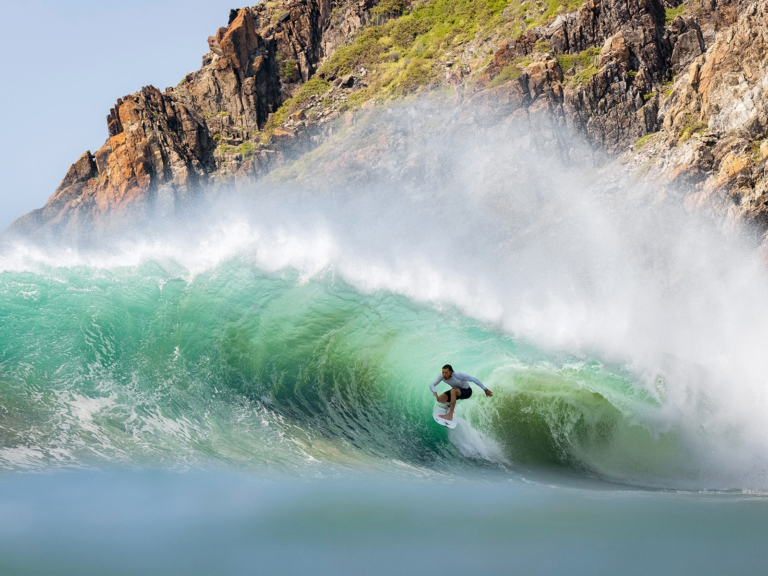
Kyle boards the freight train.
Escondida is the darling of Salina Cruz. You’ve seen it in surf magazines, summer boardshort ads and Surfline swell features. It’s a hollow sand-bottom vortex, thick as it is tall. The wave is backdropped by a dramatic cliff, gold in the morning light, with cacti clutching its edges. Unlike other points in Salina Cruz, which can range from burgery to rippable, Escondida only has one speed—Ferrari on the Autobahn. Sand builds up along the cliff, and on big swells, the wave revs its engine. On its best days, Escondida has three barrel sections, the last is thickest and closes out into a shallow mortar of sand. If a surfer doesn’t make it out the doggy door, their best hope is to body slam the bottom using the least breakable part of their body.
The next morning, we drive to Escondida. Even before we reach the beach, I can smell the scent of salt and mist from exploding whitewater—swell is in the air. When we arrive, trucks sit on a thin seam of the beach between waves and jungle. I step out of the truck, and like all surfers, try to look stoic and vaguely unimpressed as the best waves I’ve seen in over a year riffle down the point. The inside section is lethal, whitewater’s sailing 15 feet high. Down the beach, a fisherman tries to wash his hands in the shoreline and whitewater rushes up and hits him at the knees, nearly sucking him out. “Hey, peligroso!” shouts one surf guide, as the fisherman scrambles back to shore, soaking wet.
Unlike the rest of us, Camacho doesn’t attempt to hide his excitement. He’s already waxing his board, so I follow. We wait for a lull, sprint paddle out and trade off barrels for the next three days.
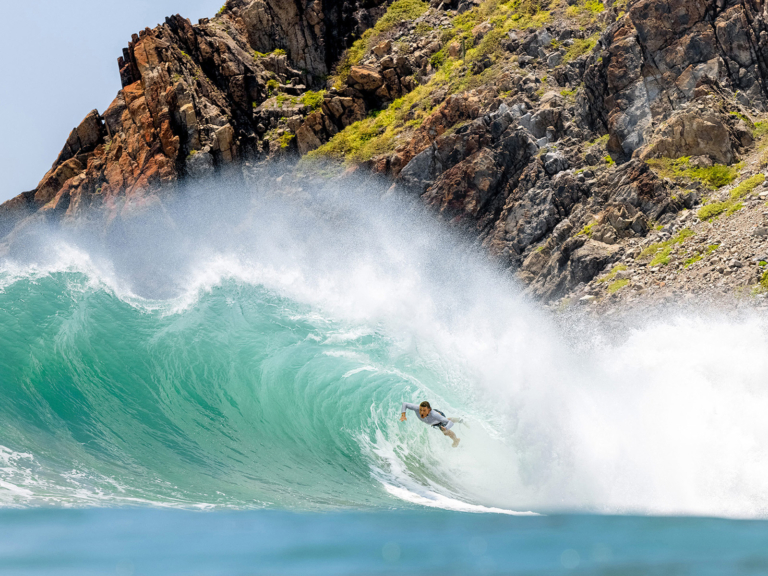
Escondida is the kind of wave that rattles windows, bones, boards and anything in its path.
Each night, I have no recollection of falling asleep, I simply face-plant, and then it is dawn. I guzzle black coffee, eat bananas, surf to exhaustion and do it again the next day. I buckle my entire quiver, courtesy of the third section at Escondida. My endorphins are shot, my face is sunburnt, my mind is stupid and happy. During the peak of the swell, our photographer, “Chachi,” captures Camacho standing confidently in a barrel. But amid the ecstasy of the swell, I can’t help but feel sad.
Punta Conejo is the southernmost point in Salina Cruz. Chivo is the next point up. Escondida lays just beyond. Sand migration makes each of these points work, and the expansion of the port will very likely turn all three waves into vestiges of the past. As durable as a heaving barrel can feel while crouched inside of it, its power is predicated upon a delicate symphony of billions of grains of sand moving freely across the seafloor and settling in throughout the surf season, unobstructed by cement.
On the final day of the trip, Camacho recommends we check Punta Conejo one last time. The swell has shifted sand and conditions may have improved. We drive down from Luna Coral and up Playa Brasil to the backside of Conejo. The tide is still too high, but the sandbar is better and fun waves run down the point.
“Conejo never disappoints,” says Camacho proudly.
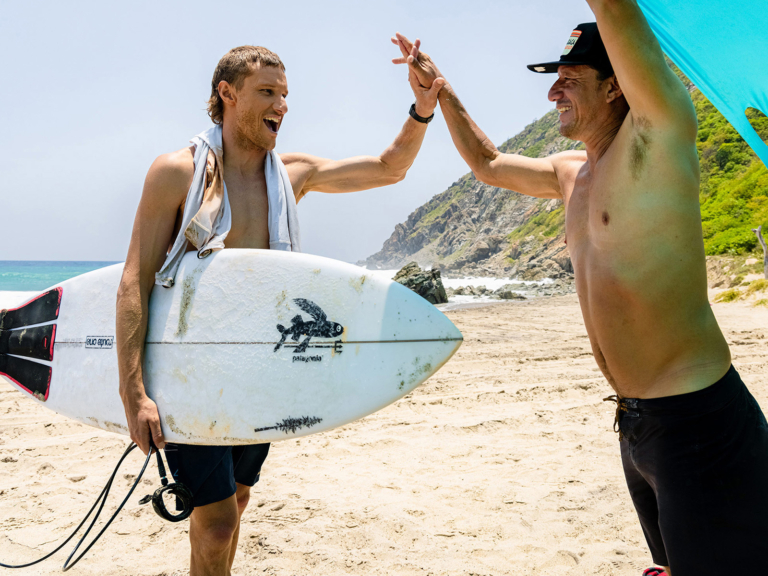
It’s probably about time for an ice-cold cervesa.
Before we surf, he asks if I want to get a view from the top of the sleeping rabbit. We hike for 10 minutes, digging our feet through sand and ivy. The top of Conejo is a 360-degree view of his surf camp, the wave, mangroves and shipping vessels out at sea. We can even see Chivo and Escondida.
“How did you think to reach out to Save The Waves?” I ask as we stand at the peak of the mountain.
He tells me that he learned about the group years prior, so he emailed them and they responded. Since that email, the director of Save The Waves, as well as board members, have made the trip down. Community meetings are in the works, petitions are online, a plan is being strategized, momentum is on their side. Maybe Camacho is taking on this project for the same reason he ran into the ocean when he was a child, ducking under waves, eventually gliding down the face of one with an outstretched arm; for the same reason he bought a single fin at a flea market and taught himself to surf; for the same reason he paddled out to an expert-only wave on the biggest swell of the season, sliding into shallow, sand-spitting barrels.
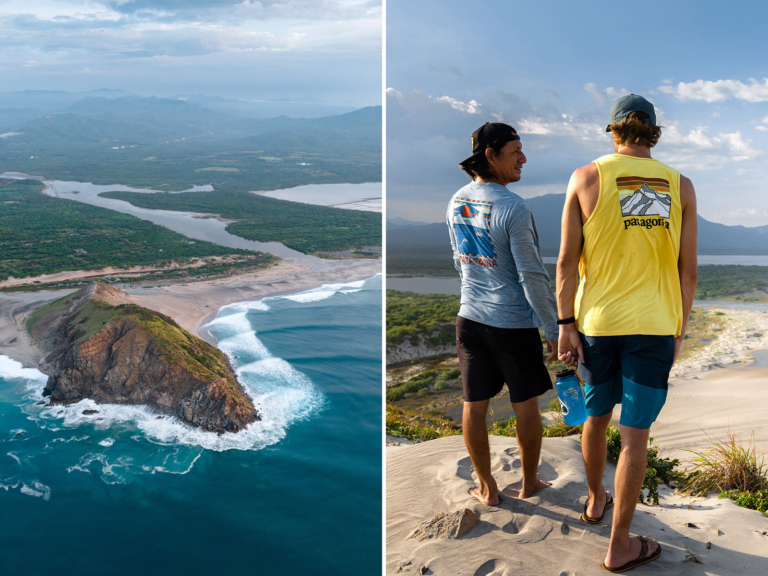
Take it all in and hopefully protect it forever.
No one told him he couldn’t.
If you’d like to speak out against the proposed port at Punta Conejo, sign the petition here.

